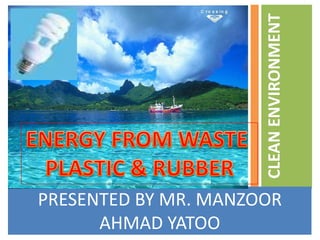
Power Generation From Waste
- 1. PRESENTED BY MR. MANZOOR AHMAD YATOO CLEAN ENVIRONMENT ENERGY FROM WASTE PLASTIC & RUBBER
- 2. MANZOOR AHMAD YETOO B.Sc (Bio), B.E. (Mechanical), MBA (Prog. Management), MSC (Environment & Ecology), Ph.D (Scholar) Environment.
- 3. Introduction One of the fastest growing materials in Municipal Solid Waste (MSW) is that of waste plastics. In the United States alone, 11.1% of the waste produced is plastic. With an annual amount in 2001 of over 229 million tons of waste, 25.4 million tons was plastic.¹ According to the EPA report “Municipal Solid Waste in The United States: 2001 Facts and Figures”, of the 11.1% or 25.4 million tons of waste plastic, only 5.5% was recycled. In the UK, over 3 million tons of waste plastics is generated per year with only 7% recycled.² In Japan the respective figures are 9.7 million tons of waste plastic with 35% being recycled in some form. Waste plastic when buried in landfills requires 50 plus years to decompose. When burned, waste plastics emit toxic and foul smelling odors into the atmosphere and now come under environmental laws in most countries. e-oil Generator is a new product has been in development for about ten years. It can economically convert the waste plastics into oil by low temperature thermal cracking in the absence of air. All kinds of PP, PE and PS waste plastics can be processed. The far infrared ray heating rods supply the heat to decompose the plastics. The products are mixed oil and emulsified heavy oil. e-oil generator is mainly composed of the waste plastic pretreatment unit, feeding and reacting unit, fractionating and blending unit, oily water treating unit and sludge emulsifying unit. It is assembled on several movable base platforms whose size is about 6000mm×2100mm. It can be operated either continuously or in batch runs, and can feed waste plastics and discharge sludge while the plant is running.
- 8. Reacting Principles PP, PE and PS are made from their respective monomer, such as propylene, ethylene and styrene. Their molecular weight is about 100000Kg/Kmol. In the high temperature, their molecular, a long chain, is first broken into shorter chain molecular, then broken into smaller molecules. Their final products are gas, oil and coke.
- 9. To convert waster Plastics & Rubber to Energy Technology: PYROLYSIS
- 10. PYROLYSIS Pyrolysis is a process of thermal degradation in the absence of oxygen.. The plastic / Rubber is pyrolised at 370ºC - 420ºC and the pyrolysis gases are condensed in a series of condensers to get oil Or feed the gas directly to Gas Engines to produce electricity
- 11. TECHNOLOGY ADVANTAGE: •Continuous plant with Controls & Instrumentation •International standards and suppliers •Simulated designs verified, HAZOP analysis completed •Simple to process, operate and maintain •Energy from alternate sources •First plant running successfully and the second plant Commissioned
- 12. PROCESS ADVANTAGE: •Minimal Sorting of material and Preprocessing like washing is required •Prevents Toxic emissions ,otherwise burnt •Can process any kind of Non-recyclable plastics •No pollution / No toxic emissions / No Odour •Eligible for Carbon Credit
- 13. • Very Economical • Price includes delivery, commissioning and training Price advantage:
- 14. Post- Sale Support: · Offer Operation & Maintenance contract · Well documented manual · 24x7 technical support
- 15. FOCUSING ON REJECTED PLASTICS
- 19. Majority of them are Non‐recyclables
- 21. Sticker Labels / tapes
- 22. Rigid plastics,
- 24. Woven sacks etc
- 25. Waste Cable husk, Carpets etc..
- 26. Tyres‐ Bicycle, two wheelers, car/truck
- 27. Rubber –Toys, tubes, mats,
- 29. Technological Flow Diagram of the Process The technological flow diagram of the process is shown in Figure 1 below. The waste plastic is fed into a plastic crusher unit where it is rendered into small pieces of about 20mm x 20mm in size. These small pieces are then transported into the auto-sealed screw feeder system and then pushed into the reactor where they are turned into a liquid state by the temperature of the heating system. The sediments like sand, mud, sludge and etc. are discharged out of the bottom of the reactor while the plant is running. The molten liquid plastic will flow into the non-catalytic cracking unit where the liquid is cracked into gas and fuel oil vapor and then leaves out of the top of the unit to go to the condenser and cooling tower. The cracking coke is also eliminated through the bottom of the reactor. The gas will be compressed into liquid gas (LPG) and dry gas. The liquid gas (LPG) is high quality and can be used in residential homes for cooking. The dry gas can be used for commercial plant furnace operation. The fuel oil mixture from the cracking process is sent through the extraction and fractionation process where high-grade fuel oils are obtained. Note that both the dry gas and the fuel oil can be used to power the generators to produce electricity for in-plant use and to re-sell to the local power grid.
- 35. Growth Market- RM always available
- 36. Sustainable Technology & Products
- 38. Quick Returns > 40%
- 39. Multiple advantages•Environmental •Social & •Business
- 40. . ‘ Carbon Credit • Eligible for Carbon Credit under the category of Fossil Fuel replacement • For every ton of Fossil Fuel replacement, 3 points are awarded
- 44. Thank You
